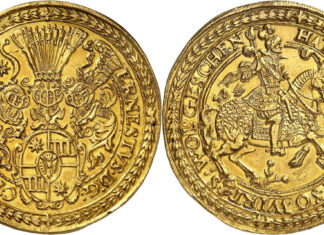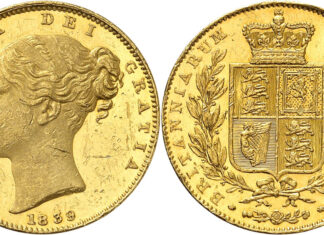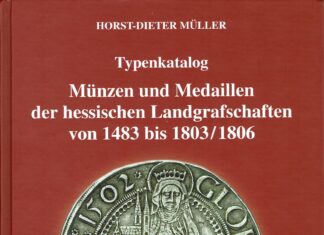Tag: Germany (Modern Period)
Gold From Coal and Stone: Ernst III of Holstein-Schauenburg
While others ruined themselves with enormous buildings, Ernst III was one of the beneficiaries of early absolutism. He supplied others with the material needed for construction and metalworking. On 28 January 2021, auction house Künker offers a 10fold ducat of this enterprising count.
Lösers in Death Rituals: The Funeral of John Frederick of Brunswick-Calenberg
On 28th January 2021 auction house Künker offers selected lösers from the Popken Collection. One of them gives us a clue as to what lösers may have been used for. We learn from a book that this coin was distributed as a gift of honour to the princely attendees of the funeral of John Frederick of Brunswick-Calenberg.
Movie Stars Instead of Generals – How the “Seventh Art” Established Itself on Commemorative...
Films have been around for about 120 years establishing the much-admired film stars, who are among the most famous personalities of all times. Nevertheless it took a long time until actors appeared on coins and medals. Why? What changed? Let’s go on a little journey through time.
The D-Mark Era: Now Available on Cosmos of Collectibles
A new numismatic field was uploaded to our database Cosmos of Collectibles: all coins of the era of the Deutsche Mark, which was the German currency before the euro and since 1948. We invite you to browse through!
The Gold Standard Part 2: How and Why Gold Became the Most Important Metal...
For centuries, silver was the preferred metal across the world when it came to coins and savings. In the 19th century, that changed. We’ll explain how and why, and illustrate what happened with the help of coins that will be coming under the hammer on 30 September and 1 October 2020 in the Künker Auction entitled ‘A Numismatic Gold Treasure’.
The Gold Standard Part 1: How and Why Gold Became the Most Important Metal...
For centuries, silver was the preferred metal across the world when it came to coins and savings. In the 19th century, that changed. We’ll explain how and why, and illustrate what happened with the help of coins that will be coming under the hammer on 30 September and 1 October 2020 in the Künker Auction entitled ‘A Numismatic Gold Treasure’.
Extensive Catalogue of Coins From the Landgraviates of Hesse
Last autumn, after decades of work, Horst-Dieter Müller published his extensive catalogue of coin and medal types from the Landgraviates of Hesse from 1483 to 1806. Daniel Baumbach takes a look.
What Can Be Seen on Euro Coins: The Brandenburg Gate Part 2
It took a long time for the Brandenburg Gate to be featured on German 10, 20 and 50 cent coins. There is simply no better symbol to remind of the reunification of East and West Germany after the Iron Curtain came down.
What Can Be Seen on Euro Coins: The Brandenburg Gate Part 1
Every motif on euro coins represents a country’s national identity. It took a long time for the Brandenburg Gate to be featured on German 10, 20 and 50 cent coins. At the beginning, the monument was extremely controversial, the architect was even mocked for it.
30 Years of Monetary Union
On 1 July 1990 the financial union between the Federal Republic of Germany and the GDR took effect, requiring a large quantity of Deutsche Mark banknotes to be produced in a very short time. Half of this additional demand was produced by Giesecke+Devrient.












